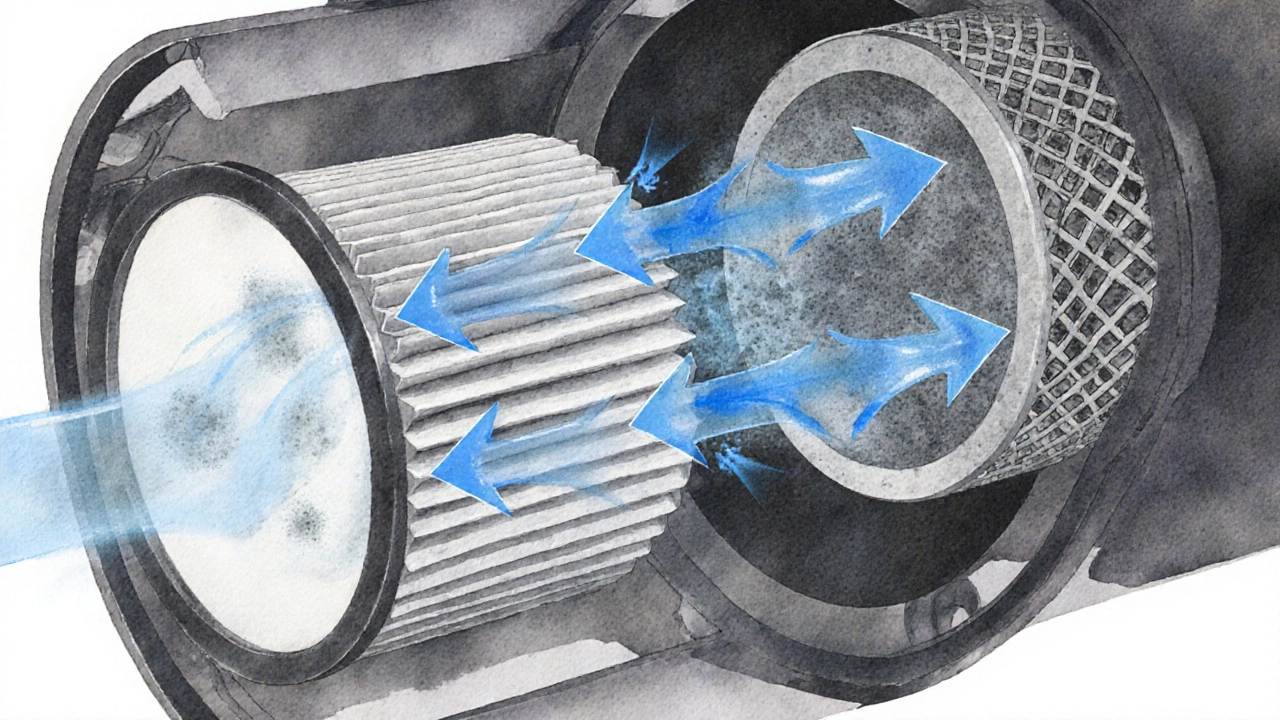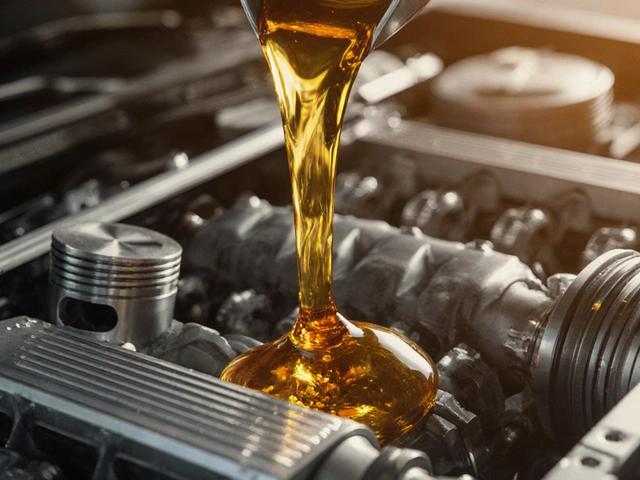Air Filter Cost Calculator
Calculate your long-term costs for paper vs washable air filters based on your driving habits. This tool helps you understand the financial impact of each filter type over 5 years.
Key Takeaways
- Paper filters give the highest filtration efficiency for fine dust but need routine replacement.
- Washable filters keep Maintenance Cost low by being reused, but they lose efficiency faster under heavy dust loads.
- Airflow loss is the main performance metric; paper filters typically drop less than washable ones after many cleaning cycles.
- If you drive in dusty conditions, a paper filter is safer for engine longevity; for city commuters with light traffic, a washable filter can save money.
- Use the quick decision checklist at the end to match your driving habits with the right filter type.
Choosing the right air filter feels like a small decision, but it can affect fuel economy, engine wear, and how often you’re at the garage. The market offers two popular families: Paper Air Filter is a disposable element made from pleated cellulose fibers that trap dust as air passes through. On the other side, Washable Air Filter is a reusable mesh or foam that you clean and reinstall. Let’s break down how each performs, how much they cost over time, and which driving conditions favor one over the other.
How Air Filters Work
All filters share three core jobs:
- Allow enough Airflow to keep the engine breathing.
- Capture particles of different Particle Size (from large sand grains down to sub‑micron soot).
- Protect the Engine Performance by keeping contaminants out of the combustion chamber.
When a filter clogs, airflow drops, the engine works harder, fuel consumption rises, and power can dip. The key is balancing clean‑air capture with minimal flow restriction.
Paper Air Filters: What They Are
Paper Air Filter is a type of disposable filter that uses tightly packed cellulose fibers, often coated with a synthetic polymer to boost particle capture. Because the fibers are densely packed, paper filters excel at trapping even the tiniest dust particles-typically achieving 99% efficiency for particles larger than 5µm.
Key attributes:
- Filtration Efficiency: 95‑99% for fine dust; up to 99.9% for larger debris.
- Typical Lifespan: 12000‑15000km (7‑9kmi) in normal traffic; shorter in off‑road or construction zones.
- Airflow Impact: Minimal pressure drop when new; rises by ~15% at end‑of‑life.
- Cost per Unit: $8‑$15 (USD) for OEM‑grade replacements.
Installation is simple: drop it into the housing and secure the clamps. Once the filter reaches its service limit, you replace it with a fresh one.

Washable Air Filters: What They Are
Washable Air Filter is a reusable filter made from foam, cotton gauze, or synthetic mesh that can be cleaned with water, mild detergent, or specialized cleaning solutions. The open‑cell structure lets air flow freely, but it also lets the smallest particles slip through, especially after a few cleaning cycles.
Key attributes:
- Filtration Efficiency: 70‑85% for particles>10µm; drops to ~60% for 5‑10µm after several washes.
- Typical Lifespan: 40000‑60000km (25‑35kmi) if cleaned regularly.
- Airflow Impact: Very low pressure drop even when dirty-often 5% or less.
- Initial Cost: $25‑$45 for a quality set (includes cleaning kit).
Cleaning routine: spray off loose dust, soak in a cleaning solution, rinse, dry completely, and apply a layer of oil (if required). Miss a step and you risk adding oil to the intake, which can foul the engine.
Performance Comparison
The biggest questions drivers ask are: Does a washable filter let in more dirt? Does a paper filter choke the engine? Below is a side‑by‑side look at the most relevant metrics.
| Metric | Paper Air Filter | Washable Air Filter |
|---|---|---|
| Filtration Efficiency (≥5µm) | 95‑99% | 70‑85% |
| Airflow Restriction (new) | ~5kPa | ~2kPa |
| Pressure Drop at End‑of‑Life | ~15% increase | ~5% increase |
| Typical Replacement / Cleaning Interval | 12000‑15000km | Every 5000‑7000km (clean) |
| Cost Over 60000km | ~$40‑$60 | ~$30‑$45 (incl. cleaning kit) |
Notice the trade‑off: washable filters stay breezy longer, but they let more dust past. In high‑dust environments, that extra 10‑15% of particles can accelerate cylinder wear.
Cost & Maintenance Over Time
Let’s put some numbers on the floor. Assuming a driver covers 20000km (12500mi) per year and lives in a temperate climate, here’s a five‑year cost projection.
- Paper Filter: Replace every 12000km → 4‑5 replacements per year. At $12 each, five years cost $240‑$300.
- Washable Filter: Clean every 6000km → 3‑4 washes per year. Cleaning solution and oil run about $4 per wash, plus the one‑time $35 purchase. Five‑year total ~ $115‑$150.
Beyond cash, consider Maintenance Time: a paper swap takes 2‑3 minutes, while a proper wash needs 10‑15 minutes plus drying time. If you hate the garage, the paper’s convenience might outweigh the money saved.

Real‑World Scenarios: When to Choose Which
Scenario 1 - Daily city commute, mild traffic: Dust levels stay low, mileage is moderate. A washable filter can easily stay clean with a quick rinse every 5000km. You’ll save about $150 over five years and enjoy a consistently high airflow.
Scenario 2 - Rural farm or construction site: Gravel roads, high sand content, and frequent engine revs. The extra dusty air can overload a washable filter’s mesh. A paper filter’s higher efficiency protects the engine, even if you replace more often.
Scenario 3 - Performance‑oriented driving (track days, turbocharged engines): Any extra particle can scorch a high‑compression cylinder. Most experts recommend a premium paper filter (or a high‑flow paper with oil‑treated media) for maximum protection.
Scenario 4 - Budget‑conscious fleet manager: With many vehicles, the cumulative cost of disposable filters adds up fast. Switching the fleet to washable filters can cut filter expenses by up to 45%, provided the cleaning process is standardized and staff are trained.
Common Pitfalls & Pro Tips
- Don’t skimp on drying: Wet foam in a washable filter can melt plastic components.
- Watch oil buildup: Over‑oiling a washable filter reduces filtration efficiency dramatically.
- Check the housing seal: A cracked intake housing negates the filter’s benefits, letting unfiltered air slip in.
- Match filter rating to engine: Some high‑performance engines require a minimum MERV‑13 rating; most paper filters meet this, while many washable ones don’t.
- Replace filters after extreme events: A sudden sandstorm can overload any filter. Swap to a fresh paper filter before the next drive.
Quick Decision Checklist
- Do you drive mostly on paved city roads?
Yes → Washable filter may be best. - Do you often travel on dusty backroads or work sites?
Yes → Choose paper filter. - Is minimizing maintenance time a priority?
Yes → Paper filter. - Do you want to lower filter costs over several years?
Yes → Washable filter. - Is engine longevity under harsh conditions critical?
Yes → Paper filter.
Answering these quickly tells you which side of the table to sit on.
Frequently Asked Questions
Can a washable filter be used in a turbocharged engine?
Yes, but only if the filter’s flow rating meets the engine’s specs. Many manufacturers list a minimum MERV rating for turbocharged units; verify that the washable filter’s rating is equal or higher. Otherwise, you risk reduced boost pressure and higher exhaust temperatures.
How often should I clean a washable filter in dusty conditions?
Every 3000‑4000km (2000‑2500mi) is a safe rule of thumb when the road surface is sand‑laden. Check the visual condition: if the mesh looks gray or the oil film appears thick, clean it immediately.
Will using a paper filter improve fuel economy?
A clean paper filter typically has a slightly lower pressure drop than a clogged washable filter, which can translate to 1‑2% better fuel economy. The gain is modest but noticeable over long distances.
Is it safe to oil a washable filter for a gasoline engine?
Most modern gasoline engines do fine with a thin oil coating, as the oil helps capture fine particles. However, diesel engines are more sensitive; excess oil can cause carbon buildup on injectors.
What’s the environmental impact of disposable paper filters?
Paper filters are typically made from recycled fibers, but the disposal frequency adds up. Over a vehicle’s life, a driver may discard 8‑10 filters, contributing to landfill waste. Washable filters reduce that burden, especially when a proper cleaning solution is used.






